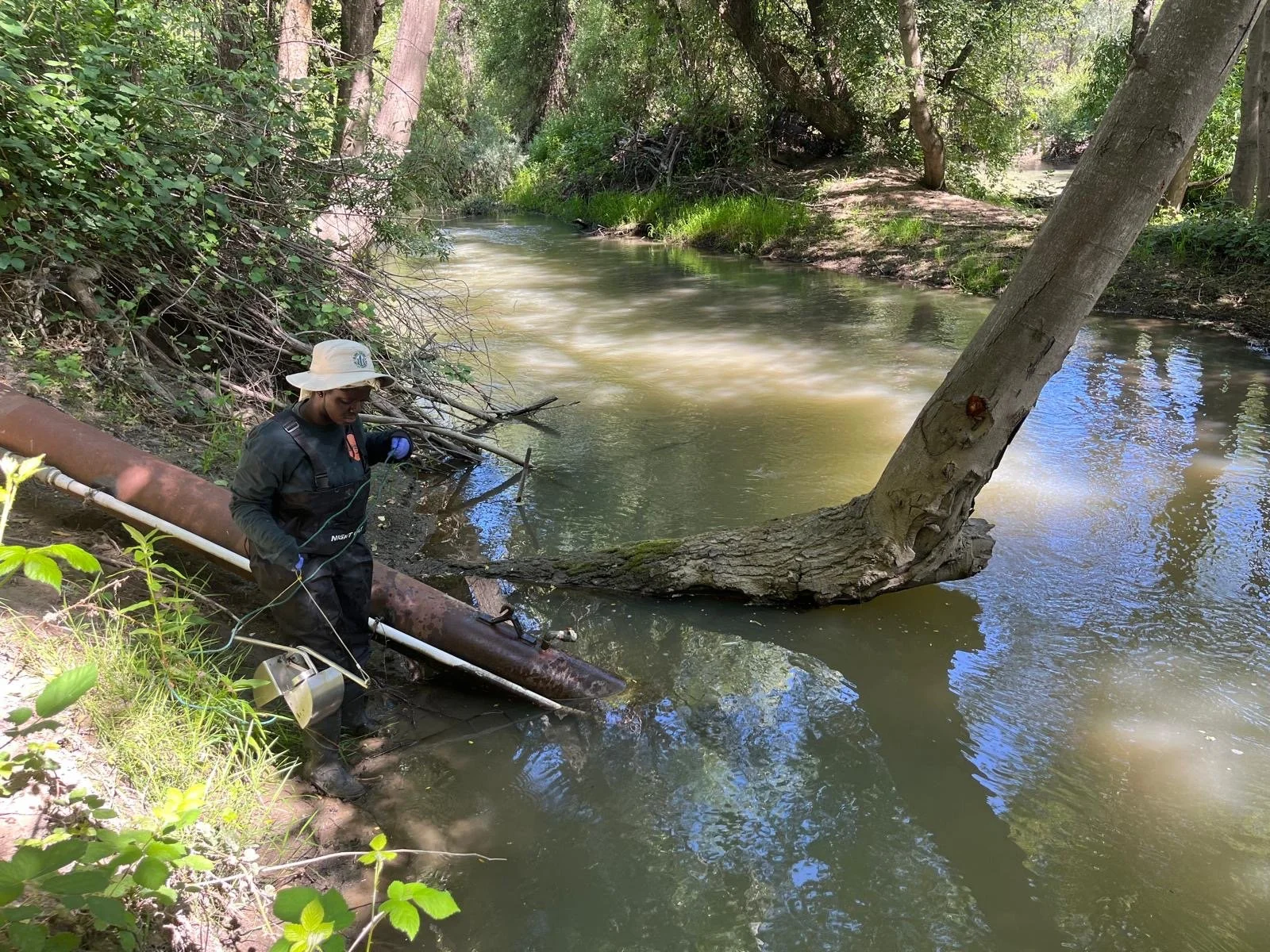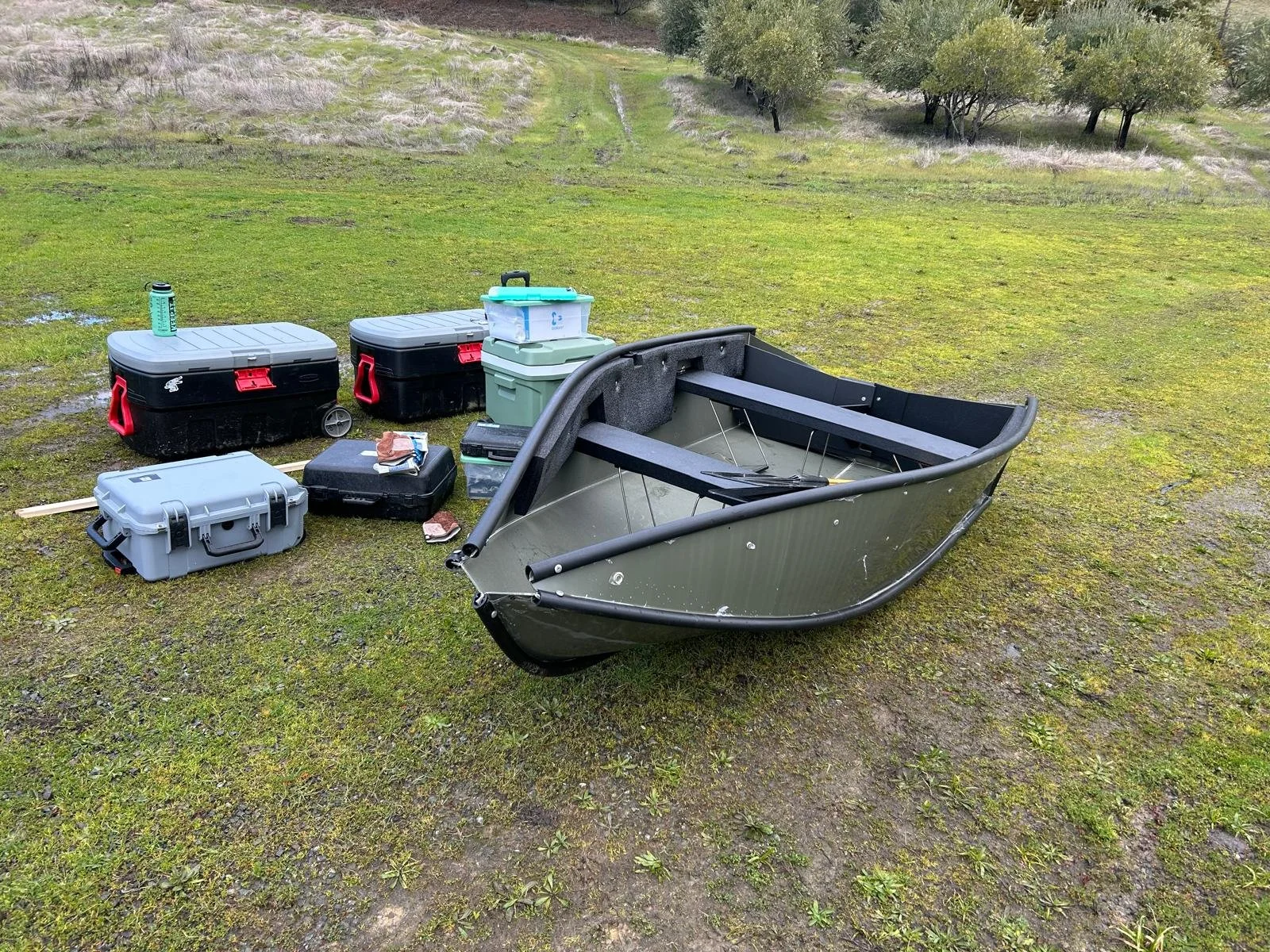Do Solar and Water Mix? Wild Energy Center Studies Heavy Metal Leaching
Moreen Akomea-Ampeh waves into a creek to collect data on water quality. Photo by Elliott P. Steele
UC Davis Wild Energy Center establishes research protocols to test floating solar sites for heavy metal contamination
Ghana’s water systems are in crisis. More than half of the fresh water bodies in the country are contaminated with heavy metals, a downstream effect of illegal gold mining operations. UC Davis PhD candidate and Wild Energy Center scholar Moreen Akomea-Ampeh grew up in the region. She saw the pollution of rivers and streams firsthand.
“Hey, this water body used to be clean, but now it looks muddy. It used to be blue, but now it’s brown,” Akomea-Ampeh said. “That water doesn’t look normal.”
When she thinks about those degraded natural resources, Akomea-Ampeh follows the consequences downstream. Who uses this water? What impact will the toxic metals have in their lives?
“What about people who don't have money to actually purchase bottled water? What happens to them?” she asks.
Akomea-Ampeh’s international experience has given her a deep appreciation for clean water as a human right and launched her scientific career studying the processes of heavy metal contamination in all kinds of settings.
This commitment to environmental justice inspired her most recent research paper, which examines the potential for heavy metal contamination caused by floating photovoltaic solar energy projects, also known as FPV. That kind of solar project is a novel approach to energy generation where photovoltaic panels float atop water bodies, oftentimes, manmade reservoirs or holding ponds.
Akomea-Ampeh’s article, Metal contaminant risk at active floating photovoltaic sites and future research roadmap, establishes guidelines for evaluating the risk of metal contamination leaching from floating solar panels into the water below. To understand this issue, she studied two FPV projects, both water treatment holding ponds.
Spot the new member of the Wild Energy Center (yet-to-be-named boat) alongside field gear as Moreen Akomea-Ampeh and Dr. Elliott P. Steele prepare for their first sample collection of the day. Photo by Moreen Akomea-Ampeh
Before collecting data on the heavy metal concentrations in the water, Akomea-Ampeh wasn’t sure what to expect – to her knowledge, no one had done a study like this before. But she was motivated to ensure this renewable energy solution doesn’t carry unforeseen problems along with it.
“Water is an important commodity. We need it for human survival and also for wildlife,” Akomea-Ampeh said. “Is it actually a good idea for us to be deploying solar on water?”
The paper’s lead author and Wild Energy Center Director, Dr. Rebecca R. Hernandez, agrees that data from FPV sites is urgently needed.
“Increasingly, public responses towards new renewable energy technologies can be about real or perceived risks related to water and soil contamination,” Hernandez said. “Unfortunately, there is a dearth of evidence to allay public concerns.”
Based on the results of this recent UC Davis pilot study, the water bodies tested did not indicate elevated levels of heavy metals. That suggests these particular solar panels successfully kept toxic materials safely contained in their core layers. But that doesn’t mean the case is closed.
According to Akomea-Ampeh, this isn’t enough data to confirm whether FPVs are “good” or “bad.” We need data from other sites, in different conditions. That includes understanding all sources of heavy metal contamination and conducting rigorous tests of those inputs before and after FPV is installed. For Akomea-Ampeh, this is just the beginning of a long-term investigation.
The UC Davis Wild Energy Center team collected data at two FPV sites to gauge heavy metal concentrations. Photo by Moreen Akomea-Ampeh
“We really need to up our game,” Akomea-Ampeh said. “We've had floating solar for about 10 years in our water resources, and we do not know if there's a potential for these FPVs to leach or not.”
She hopes to see more experiments repeat her methods to confirm whether her results were a coincidence, or if they actually represent real-world conditions. As for her next research project, Moreen is applying her understanding of environmental processes to examine heavy metals in another context – leaching on large, ground-mounted solar projects, one of the most widely-adopted types of solar facilities.
UC Davis Professor and Wild Energy Center Director Rebecca R. Hernandez was the lead author on the FPV contamination paper. Other UC Davis co-authors include Drs. Eliot A. Atekwana, Elliott P. Steele, Alex E. Cagle and Steven Sadro. Additional authors include Alona Armstrong of Lancaster University, Stephen J Thackeray of the UK Centre for Ecology & Hydrology, Olusola O. Ololade of University of the Free State and Olatubosun A. Fasipe of UC Berkeley.



